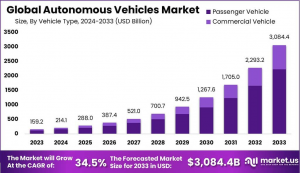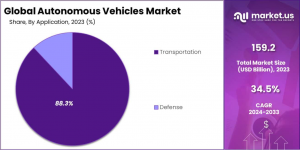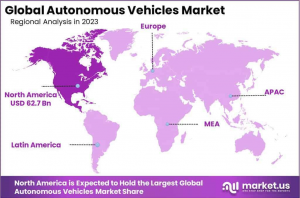Global Autonomous Vehicles Market size is expected to be worth around USD 3,084.4 Billion by 2033, from USD 159.2 Billion in 2023, growing at a CAGR of 34.5%.
North America leads the Autonomous Vehicles Market with 39.4% share, valued at USD 62.7 billion, driven by tech infrastructure, R&D, and favorable regulations.”
NEW YORK, NY, UNITED STATES, January 22, 2025 /EINPresswire.com/ -- Market Overview— Tajammul Pangarkar
The Global Autonomous Vehicles Market size is expected to be worth around USD 3,084.4 Billion by 2033, from USD 159.2 Billion in 2023, growing at a CAGR of 34.5% during the forecast period from 2024 to 2033. North America dominated a 39.4% market share in 2023 and held USD 62.7 Billion in revenue from the Autonomous Vehicles Market.
The Autonomous Vehicles (AVs) market refers to the development and deployment of self-driving cars and transportation systems that operate without human intervention. This market encompasses various segments, including hardware (sensors, cameras, LIDAR, etc.), software (AI algorithms, navigation systems), and key players in automotive and technology industries.
AVs are anticipated to revolutionize transportation by improving safety, efficiency, and reducing costs in logistics, while also contributing to environmental sustainability through the reduction of emissions.
The Autonomous Vehicles market is experiencing exponential growth, driven by advancements in AI, machine learning, and sensor technologies. Key market players are heavily investing in research and development, while partnerships between traditional automotive manufacturers and tech companies are accelerating AV innovation.
The rise of autonomous taxis and delivery services further highlights the potential of the AV market in reshaping mobility. Government investments are pivotal in supporting infrastructure development, safety standards, and research into the social and economic impacts of autonomous technologies.
Additionally, evolving regulations and policies, particularly in regions like the U.S. and Europe, are playing a crucial role in fostering a conducive environment for AV growth. This regulatory framework ensures the safe deployment and testing of AVs, while addressing concerns about liability, privacy, and cybersecurity.
For both new and established players in the Autonomous Vehicles market, strategic decisions are critical to capitalizing on emerging opportunities. This market research report offers actionable insights on industry trends, consumer preferences, and key technological innovations, enabling players to make informed decisions on partnerships, product development, and market entry strategies.
New entrants should focus on niche segments such as autonomous delivery or shared mobility solutions, while incumbents could explore collaborations with tech firms to advance autonomous driving systems. Leveraging these insights, businesses can gain a competitive edge and expand their market presence effectively.
Curious About Market Trends? Request Your Complimentary Sample Report Today: https://market.us/report/autonomous-vehicles-market/free-sample/
Key Takeaway
-The Global Autonomous Vehicles Market size is expected to be worth around USD 3,084.4 Billion by 2033, from USD 159.2 Billion in 2023, growing at a CAGR of 34.5% during the forecast period from 2024 to 2033.
-In 2023, Passenger Vehicles held a dominant market position in the by-vehicle type segment of the Autonomous Vehicles Market, with a 72.3% share.
-In 2023, Level 1 held a dominant market position in the By Level segment of the Autonomous Vehicles Market, with a 48.3% share.
-In 2023, Transportation held a dominant market position in the By Application segment of the Autonomous Vehicles Market, with an 88.3% share.
-North America dominated a 39.4% market share in 2023 and held USD 62.7 Billion in revenue from the Autonomous Vehicles Market.
Use Cases
1.Ridesharing and Taxi Services: Autonomous vehicles can transform the ridesharing industry. Companies like Uber and Lyft could use self-driving cars to reduce costs associated with human drivers. This would make rides more affordable and accessible, especially in busy urban areas. The technology could also improve safety by removing the risk of human error and allow vehicles to operate 24/7.
2. Logistics and Delivery Services: Autonomous vehicles can revolutionize goods delivery. Companies like Amazon and FedEx are exploring self-driving trucks and drones to deliver packages faster and more efficiently. Self-driving vehicles can work around the clock, reducing delivery times and lowering transportation costs. They also improve accuracy by using advanced navigation systems to avoid errors.
3. Public Transportation: Self-driving buses and shuttles can improve urban mobility. Cities could deploy autonomous buses to transport passengers on fixed routes, reducing the need for human drivers. This would make public transportation more affordable and increase convenience by reducing waiting times. It could also reduce traffic congestion by optimizing routes and schedules.
4. Fleet Management for Businesses: Businesses that rely on large vehicle fleets (e.g., delivery, construction, or service companies) can use autonomous vehicles to streamline operations. Self-driving trucks or vans can reduce labor costs, improve fleet efficiency, and decrease downtime due to driver fatigue. These vehicles can also gather real-time data to help companies optimize routes, track performance, and maintain vehicles.
5. Autonomous Vehicles for Elderly and Disabled Individuals: Self-driving cars can greatly benefit people with mobility challenges. Autonomous vehicles can provide a safe and convenient transportation option for the elderly or disabled, helping them maintain independence. These vehicles can be equipped with features that make it easier for passengers to enter and exit, and also include voice-controlled interfaces for added accessibility.
Driving Factors
Technological Advancements in AI and Machine Learning: The continued development of artificial intelligence (AI) and machine learning technologies is a major driver of the autonomous vehicle market. These technologies enable vehicles to process data in real time, improving safety and navigation without human intervention.
Government Support and Regulatory Frameworks: Governments across the world are investing in autonomous vehicle research and development. They are also creating regulations that support the safe testing and deployment of autonomous vehicles, which encourages industry growth.
Decreasing Costs of Sensors and Components: The cost of sensors, cameras, radar, and LiDAR systems used in autonomous vehicles has decreased significantly. As these technologies become more affordable, it becomes easier for manufacturers to integrate them into vehicles, making autonomous vehicles more accessible.
Consumer Demand for Safety and Convenience: With safety being a top concern for consumers, autonomous vehicles offer the potential to reduce human error, which is the cause of most road accidents. The growing demand for safer and more convenient transportation options is driving the adoption of autonomous technologies.
Collaborations Between Automakers and Tech Companies: Strategic partnerships between traditional automakers and technology companies are accelerating the development of autonomous vehicles. Tech firms bring expertise in AI and software, while automakers provide the manufacturing infrastructure, helping to speed up the commercialization of autonomous vehicles.
Report Segmentation
In 2023, passenger vehicles dominated the autonomous vehicles market by vehicle type, holding 72.3% of the market share, reflecting strong consumer demand for autonomous features in personal transportation, driven by a focus on safety, convenience, and innovation. Level 1 autonomy led the market by level, with a 48.3% share, offering basic driver assistance like lane-keeping and adaptive cruise control, which are popular for their safety benefits and lower cost. The transportation sector also held a dominant 88.3% share in the application segment, highlighting the significant role of autonomous technology in revolutionizing both public and private transportation.
By Vehicle Type
~Passenger Vehicle
~Commercial Vehicle
By Level
~Level 1
~Level 2
~Level 3
~Level 4 & 5
By Application
~Transportation
~Defense
Ready to Act on Market Opportunities? Buy Your Report Now and Get 30% off: https://market.us/purchase-report/?report_id=100259
Regional Analysis
The Autonomous Vehicles Market shows different rates of adoption and progress across regions, with North America leading the way with a 39.4% market share, valued at USD 62.7 billion. This leadership is mainly due to advanced technological infrastructure, large investments in research and development, and favorable regulations that encourage innovation and deployment in the U.S. and Canada.
Growth Opportunities
Government Regulations and Policy Support: Governments around the world are beginning to implement supportive policies and regulations for autonomous vehicles. Investing in autonomous vehicle technology now can position companies to benefit from government incentives and early market access as the legal frameworks for self-driving cars are established.
Partnerships with Ride-Hailing Services: Autonomous vehicles are a natural fit for the ride-hailing market, reducing the need for human drivers. Partnering with major ride-hailing platforms like Uber or Lyft can help accelerate the adoption of autonomous vehicles in urban environments and expand market share.
Fleet Solutions for Logistics Companies: Autonomous trucks and delivery vehicles can dramatically reduce transportation costs and improve efficiency for logistics companies. Investing in autonomous fleet solutions for large-scale deliveries and cargo transport offers a lucrative opportunity in the logistics sector.
Technological Advancements in AI and Sensor Systems: As AI, machine learning, and sensor technology continue to improve, autonomous vehicles will become safer and more reliable. Companies that invest in developing and perfecting these technologies, such as LIDAR, radar, and AI software, will be well-positioned to lead the market.
Consumer Adoption in Urban Areas: While fully autonomous vehicles are still being tested, there’s potential for quicker adoption in urban areas where traffic congestion and limited parking make self-driving cars a more attractive option. Creating autonomous ride-sharing services in cities can meet this growing demand and provide a convenient, cost-effective solution for urban transportation.
Key Players
~Honda Motor Co. Ltd.
~Ford Motor Company
~Daimler AG
~BMW AG
~Volvo Car Corporation
~Volkswagen AG
~Toyota Motor Corporation
~Tesla Inc.
~Uber Technologies Inc.
~Audi AG
~General Motors Company
~Google LLC
~Nissan Motor Co. Ltd
~Other Key Players
Not Sure? Request a Sample Report and See How Our Insights Can Drive Your Business: https://market.us/report/autonomous-vehicles-market/free-sample/
Trending Factors
Advancements in AI and Machine Learning: Autonomous vehicles rely on artificial intelligence and machine learning algorithms to make real-time decisions. As AI technology improves, so does the ability of self-driving cars to safely navigate complex road environments, increasing consumer confidence.
Government Regulations and Safety Standards: Governments are implementing and updating regulations for autonomous vehicle testing and deployment. Standards related to safety, cybersecurity, and liability are being established, which will play a crucial role in the market's growth.
Strategic Partnerships and Collaborations: Leading automotive manufacturers are partnering with tech companies and startups specializing in autonomous driving technology. Collaborations between industry giants help accelerate development and bring self-driving cars to market more quickly.
Rising Investment in Autonomous Vehicle Technology: The market is witnessing significant investment from both traditional automakers and tech giants, such as Google’s Waymo and Tesla. These investments focus on refining self-driving technologies, improving vehicle sensors, and scaling production.
Consumer Perception and Trust Building: Consumer trust in autonomous vehicles remains a key challenge. Automakers are working on educating the public about the safety and benefits of autonomous driving, while also conducting extensive testing to improve the technology and address concerns around security, reliability, and control.
Restraining Factors
Regulatory and Legal Challenges: The deployment of autonomous vehicles (AVs) faces significant regulatory hurdles. Governments around the world are still working to establish comprehensive safety and operational regulations. The uncertainty in legal frameworks can slow down the adoption and development of AVs.
Public Trust and Safety Concerns: Despite advancements in technology, many consumers are still hesitant to trust autonomous vehicles due to safety concerns. High-profile accidents involving AVs, even though rare, have raised doubts about the safety of these vehicles, hindering widespread adoption.
High Development and Production Costs: The cost of developing autonomous vehicle technologies, including artificial intelligence, sensors, and advanced computing systems, is extremely high. These costs must be passed onto consumers or absorbed by manufacturers, making it harder for AVs to compete with traditional vehicles in terms of affordability.
Conclusion
The Global Autonomous Vehicles Market, poised to grow to USD 3,084.4 billion by 2033, represents a transformative shift in transportation driven by rapid advancements in AI, machine learning, and sensor technologies. As North America continues to lead with significant market share, the sector sees robust investment and innovation from key players, creating substantial growth opportunities in passenger transport, logistics, and public mobility. Strategic collaborations and government support are vital as companies navigate the challenges of regulatory landscapes and consumer trust. By focusing on technological enhancements, reducing costs, and increasing public awareness, the autonomous vehicle industry can fully capitalize on its potential to revolutionize transportation, making it safer, more efficient, and accessible.
Lawrence John
Prudour
+91 91308 55334
Lawrence@prudour.com
Visit us on social media:
Facebook
LinkedIn
Legal Disclaimer:
EIN Presswire provides this news content "as is" without warranty of any kind. We do not accept any responsibility or liability for the accuracy, content, images, videos, licenses, completeness, legality, or reliability of the information contained in this article. If you have any complaints or copyright issues related to this article, kindly contact the author above.




